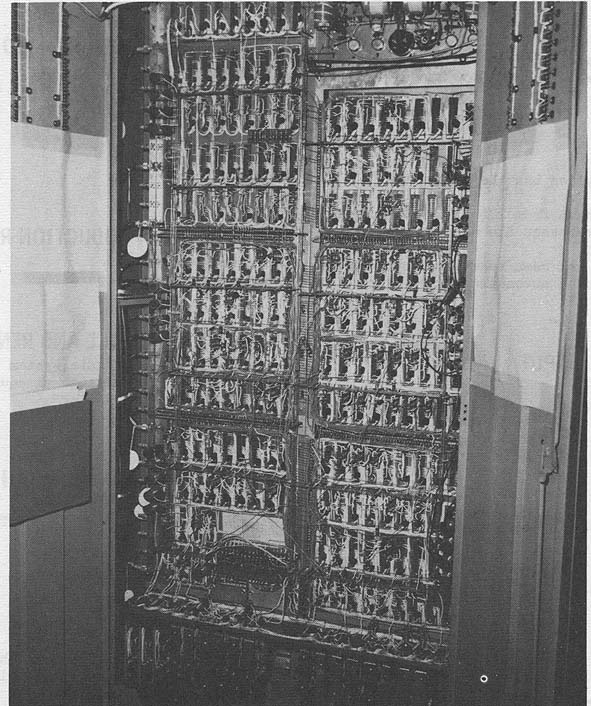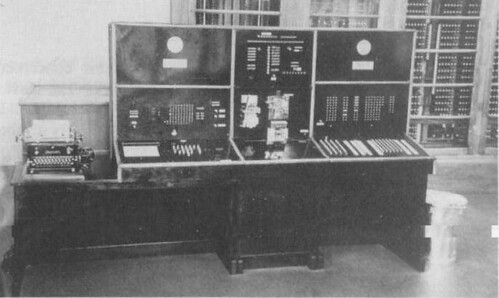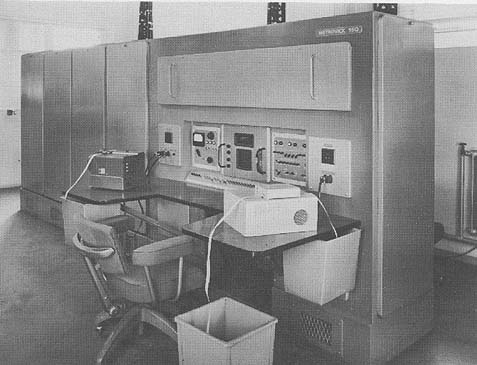[This is the last part of trilogy[to read the previous parts, click here]
The mighty transistor
What is significant of the year 1947? Every Indian knows it's the year we attained freedom.But it's also the year when a major breakthrough happened, which has impacted the world so much that such an influential invention is yet to come.This was it—the invention of the century, indeed, no invention has surpassed this one to date. On 16 December, 1947, at The Bell Laboratories, William Shockley, John Bardeen, and Walter Brattain invented the transistor.Need less to say, that much of our life depends on it! William Bradford Shockley was awarded the Nobel Prize for physics in 1956.
Small Scale Experimental Machine
In the successive year,the SSEM (Small Scale Experimental Machine) was built at Manchester University, based on ideas from John von Neumann, a Hungarian Mathematician, about stored program computers. All modern computers use the Von Neumann architecture, as it is called.Essentially, this was the first computer ever to store both programs and data in memory!.
EDVAC
The EDVAC (Electronic Discrete Variable Computer) was the first computer to use magnetic tape,it was proposed in 1949 by John von Neumann and completed in 1952 at the Institute for Advanced Study, Princeton.It was a breakthrough, because earlier computers could only be reprogrammed by re-wiring them.The EDVAC gave users the luxury of loading new programs off the tape.
Z3 to Z4
In the year 1950,Zuse’s Z4 Konrad Zuse,leased his Z4 computer in July to the ETH Zurich, a well-known university, making the Z4 the first commercial computer. Zuse, in addition to his computers, including the Z3, also designed the first high-level programming language, the Plankalkül, and founded the first “computer start-up.”
UNIVAC
Though transistor was invented already, it's potential as an electronic device was not realised yet and the manufacturing method was yet to be practiced at a large scale.So the computers that came around were still using relays and vacuum tubes.In 1950,The UNIVAC I (Universal Automatic Computer), the first commercial multipurpose computer, was delivered by Remington Rand to the US Census Bureau.The machine cost about $1 million to build, weighed 13 tons!.The clock speed was 2.25 MHz, and the main I/O devices were magnetic tape and punch-cards. About 46 were built, most of them for US governmental agencies,and some for big corporations.
Whirlwind
In April of 1950,Interactivity was born.The Whirlwind, the first interactive computer that worked in real-time, was unveiled at MIT in April. Real-time interactivity literally means the computer responds to your commands so fast, you don't see the lag between the time of input of command and the time of receiving output. Before the Whirlwind, computers worked in batch mode.i.e.you keyed in instructions, went out for coffee, and got back to find the results printed out. Jay Forrester and his team at MIT’s Lincoln Labs decided to use core memory (where magnetic ceramic rings are employed) as storage; this made the computer faster. It was also the first time video was used as an output device, in the form of a giant oscilloscope screen. [Later versions were used as a backbone of SAGE, the air defence system of the US Air Force and also the first computer network. In 1956, a keyboard was integrated into the system.]
The Von Neumann Architecture
It was in 1952, a very important architecture was introduced to computing systems-the Von Neumann architecture.The IAS General Purpose Computer was completed by von Neumann and his team at the Institute of Advanced Studies, Princeton. Work on the IAS started around 1946. It was built on the design principles of what were later known as the von Neumann architecture. The first machine at Princeton served as a template for computers that were optimised for mathematical and scientific calculations in such fields as astronomy, meteorology, and hydrodynamics. These computers were used, for instance, in Los Alamos for computations that led to the design of the hydrogen bomb. Most of these computers were present in universities and research organisations; they were not designed for business users.
Computer is used for prediction
Similar to ENIAC and EDVAC,the UNIVAC secured its place in the public mind-space when it correctly predicted the winner of the presidential poll in November between Dwight D Eisenhower and Adlai Stevenson. The expert opinion favoured a close race, while a UNIVAC borrowed by CBS predicted that Eisenhower would win by a landslide. CBS did not immediately release the results, but when the actual vote count came later, had to admit that the UNIVAC had only a 3 per cent margin of error. The term “Univac” became a generic name for computers; the 1953 IBM 701 was called IBM’s Univac.Rear Admiral Dr Grace Hopper, a pioneer in programming invented the first ever compiler,for the UNIVAC I.Later versions of compilers,like ARITH-MATIC, MATH-MATIC and FLOW-MATIC were released, and were used for various purposes especially for business and scientific purposes.
IBM 701
It was time for mass production of computers.Till 1953, computers were made for special purposes and for special communities like universities,labs,defence,etc., but in 1953,IBM unveiled the IBM 701, its first mass produced computer for scientific use. It was significant in other aspects too; IBM had ventured from its core business of making punch card machines to making electronic computers. The 701 also launched the IBM 700 series—702, 704, 705, and 709 which spanned the 1950s. Known as the Defense Calculator in the developmental stage, it stored data using a Williams-Kilburn tube (a type of cathode ray tube). The 701 used assembly language[note:from the 704 (completed in 1954) onwards, FORTRAN, invented by John Backus at IBM, was used as the programming language].And it's worthy to mention that,the 701 was the first computer to demonstrate artificial intelligence by running a a kind of checkers-playing program.
Transistors take the place
In November 1953 A transistorised computer A small computer was built using transistors—the first time vacuum tubes were not used in a computer. Built by Richard Grimsdale and Doug Webb at the University of Manchester, it used 92 transistors. This prototype later became the MV950 and a total of only seven were sold.[but the first commercial transistorised computer and was built in 1959]
Semiconductors
It was time for another breakthrough in electronics that propelled computing into a whole new dimension.In April 1954,Gordon Teal of Texas Instruments' Semiconductor R&D announced at a Radio Engineers convention that silicon-based junction transistors were in commercial production. As the story goes, Teal was one of the last speakers, and general opinion was that it would take some years to perfect a silicon transistor. When Teal announced that Texas Instruments had perfected the silicon transistor, he dipped the germanium transistors of the amplifier of a record player in hot oil. The music died out (the transistors could not tolerate the heat). Next, he dipped the same rig, outfitted with silicon transistors instead of germanium , in hot oil. The music played on!.
First supercomputer
In the same year,The first “supercomputer” The NORC (Naval Ordnance Research Calculator) was delivered to the US Navy. It was the first computer to have been called a supercomputer; it could perform 15,000 arithmetical calculations in one second. Its first demonstration was to calculate the value of pi, which it calculated to an accuracy of 3,089 digits, a record at that time. The NORC was used for complicated operations like calculation of missile trajectories and plotting the orbits earth and other heavenly bodies. All these computations required billions of calculations, taking hundreds of factors into account, and were not possible using other computers of that era.
Fully transistorised
The Fully transistorised The TRADIC (TRAnsistor DIgital Computer) was the first fully-transistorised computer built in 1955[ it was built by Bell Labs for the US Air Force]. It had 700 transistors and 10,000 germanium diodes. A small and light system, TRADIC was installed on a B-52 Stratofortress bomber and consumed only 100 watts, performing about a million logical operations in one second.
Breakthrough in memory
Most of the base inventions and breakthroughs were in place, ready for the electronic age of computing, but the most important of all devices used for computing-Storage medium was yet to be developed.Computers were still using magnetic tapes or punch cards.But in 1956,the IBM 305 RAMAC (Random Access Method of Accounting and Control), the first computer to use magnetic disk drives for secondary storage instead of electrostatic tubes or magnetic drums was introduced. It was also one of the last vacuum tube computers[Later models would be solid stale,meaning comprising ICs].The capacity of the 305 was 5 million characters, which were stored onto 24-inch aluminium disks coated with magnetic iron oxide. The disks ran at 1,200 rpm, and the distance between the read head and the disk surface was 800 micro-inches (modern drives have a distance of less than 3 micro-inches).
Electronic calculator
Let's not forget the more humble yet essential contributor to day-to-day computing, which is the electronic calculator.In 1957,Casio, a Japanese company founded in 1946, released the Model 14-A, the first all-electric compact relay calculator (which in plain language means electronic circuits).Early calculators used gears and were operated by cranks or motors. Casio’s calculator, apart from being electronic, used a ten-button keypad instead of individual keys for individual numbers and a single display pane. Casio Computers Company Ltd. was also founded, and the firm is a major manufacturer of calculators, PDAs, watches, cameras,and audio equipment.
ICs
The last and final breakthrough that would be the most important of all the breakthroughs so far-The IC(integrated circuits).Jack Kilby at Texas Instruments invented the Integrated Circuit in September 1958, an invention that opened the doors to the digital age. Electronic circuits prior to the IC consisted of capacitors, transistors,resistors, and many other components individually connected by wires. Such designs occupied a lot of space and were unreliable. In the IC, every component is made of silicon, actually an extension of a tiny silicon wafer and connected by almost invisible wires. The whole set up consumes very low power, is cheap to manufacture and is very small. The IC is at the heart of any-thing electronic from wristwatches to space shuttles.Kilby received the 2000 Nobel Prize in Physics for his work.
(The following image shows the power of Integration)
Let's make somethings clear now,Who was the Father of Computing? There are several popular answers, depending on context; the favourites seem to be, in this order:
1. Alan Turing, who laid down certain rules regarding what a computing machine is
2. Charles Babbage, who designed Difference engine
(the following two are more modern contributors)
3. The inventors of the transistor (arguably the greatest invention of the 20th century and greatest invention till now): John
Bardeen, Walter Brattain, and William Shockley
4. Jack Kilby who devised the Integrated Circuit
That was the last of the last part of the trilogy.Hope it was informative and the next time someone asks you about computers, you'll be able to make their jaws drop when you give them these data.Moreover it's good that we learn about the true contributors who helped us get into the modern age.Without them,it's not possible since you could've noticed that in the initial stages,inventions and ideas span over a time period of 300 years[the early 1600 to late 1800], then the mid age of computing accelerated, contributions were frequent[early 1900 to 1946-just about 50 years]and the modern era of computing, accelerated development even further[1947 to the present date]roughly another 50 years and we have developed from a memory device that was 24 inch in size to memory cards less than a centimeter in size!That's the importance of all the contributions made by these people!.
Finally Happy Computing!













